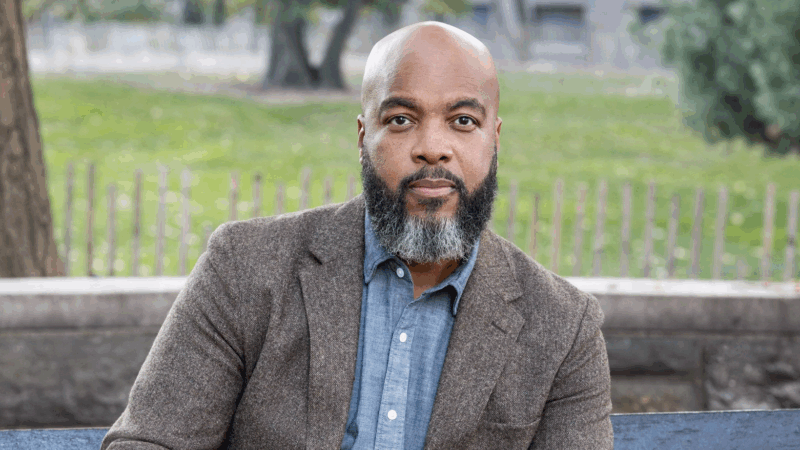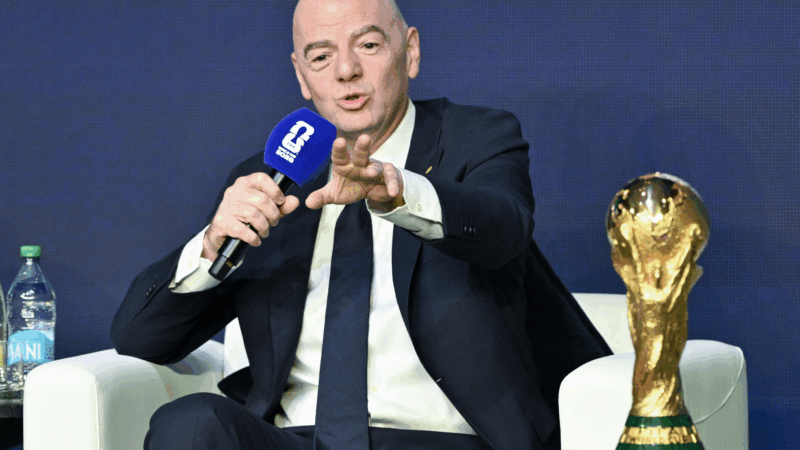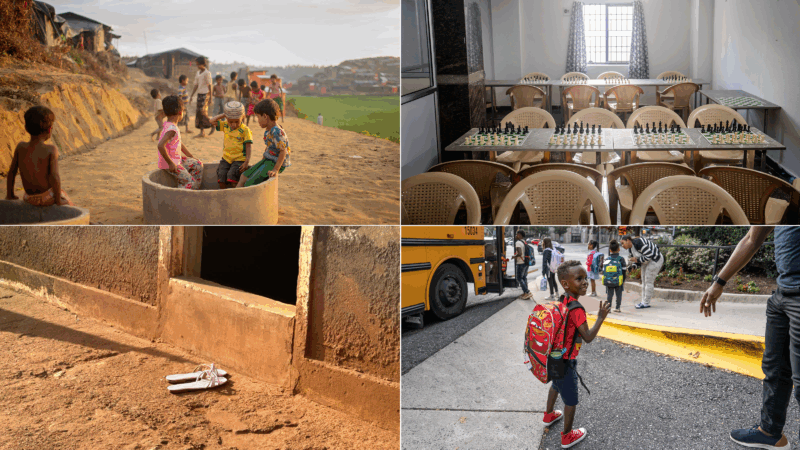Telling stories of gun violence deaths almost cost this reporter his life
When Pulitzer Prize-winning journalist Trymaine Lee was 38, he suffered a sudden heart attack that nearly killed him. The incident made him reconsider the years he had spent reporting on the lives cut short by gun violence — and the stress it had put on his body.
“For the first time really, I had to look deep and engage with what was truly bearing down on my heart,” he says. “And for me that had been more than a decade of telling stories of Black death and survival.”
As a reporter in Trenton, Philadelphia and New Orleans, Lee covered the deaths of young men who looked like him. The victims were “wearing my same sneakers, same haircut,” he says. “And you have to wrestle with seeing yourself in some ways, repeatedly gunned down, your body repeatedly falling. Tears for your death over and over and again.”
Lee’s new memoir, A Thousand Ways to Die: The True Cost of Violence on Black Life in America, is part history, and part personal turning point. He traces the bloody history Black Americans have with firearms, recalls gun violence in his own youth and follows his ancestors’ path back to Ghana.
The book reads like a plea for people to see the humanity of those lost to gun violence — and for this country to care enough to act.
“We have an opportunity and we still have this opportunity to be the great nation that we’ve professed,” Lee says. “I’m not a policy maker. I don’t profess to be an expert in gun policy. But what I do believe is that until we break our lust for these guns, nothing will change.”
Interview highlights

On President Trump’s comments about the violence in majority-Black cities
Hearing the president talk about Chicago and Baltimore and other cities, and he goes on to talk about how people in these communities were “born to be criminal[s].” The violence is innate, right? There’s something in these people that makes them inherently violent, and the gun is just their tool.
But I think one of the biggest things that people miss or don’t fully understand is that there is a direct pipeline from a slew of places with super lax gun laws that are poured right into Chicago. And that every one of these guns starts legally. And so along the pipeline, from the factory to the wholesale market, to the retail market, to stores, to gun shows, there are all these places where guns are siphoned off by the so-called good guys with guns. And so while there is violence in Chicago and there is criminality in Chicago, there’s criminality that happens long before then to allow these guns to pour into these cities in ecosystems and environments already [twisted] and bound by so much systemic violence and so much lack and so much hunger, and so much trauma that folks are carrying.
On speaking to the mothers of Black men and boys who were shot and killed
There was this string of killings, starting with like Trayvon Martin, and I got close enough to the families where they trusted me to tell their stories. In the middle of all the noise, I had a direct line to most of these families. And the look in a mother’s eyes in particular who has lost a son to murder or violence, it’s like nothing you’ve ever seen. And I still see those eyes. I’ve never been able to remove those eyes, right? The pain that you see in them, the ocean of emotion welling up in them. And that no matter what we do, all the humanizing, all of the, you know, making sense of the systems and the police and the law and all those things will not bring their child back.
On the importance of showing respect to the victims of violence
And the actual process of gathering the information for your report is also tough because you have ask dumb questions. “What did you see? What did you hear? What was it like the last time you talked to them?” Questions that are intrusive and at the worst moment in someone’s life. And then you’re asking for a picture, right? And then, you’re over there talking to the police.
There’s something exploitative by nature: I’m getting so much more out of this than you are. But I always wanted to do it humanely and with great respect. And then you have to take that back to the newsroom. And I literally had an editor once — it was after a shooting and one young person was killed and I think another one was wounded — and he said, “Oh, that’s just a garden-variety killing.” He described the killing of a young teenager. And mind you, we don’t have any context to the situation. … We don’t know how, why, who. We don’t anything. But this was so routine that it wasn’t worth covering. “Don’t worry about it, it’s garden variety.”
On struggling with the notion of “objectivity”
The kind of objectivity that we’re so often taught in this practice is a blindness. It’s like a convenient ignoring of what you actually see. I think what’s more appropriate is fairness. And that objectivity in that notion, it’s an arm’s length from your subject matter. And I never fully believed in that part. I think you have to have your facts right. I think that you have to be fair to people on as many sides as there are. But the notion of objectivity never rang solid for me.
What I managed to do, and I hope I continue to do in putting shape to the experiences of people, is going to the people and telling their story as openly and honestly as possible, and painting the picture, and bringing people into their experiences. And even when it’s painful, giving a little bit of that pain for everybody to hold. Hold a little of this. If she has to hold some; you have to hold some too.
On tracing a gun from manufacturer to use
It was so important, I think, to connect the dots between what’s happening in factory towns in Massachusetts where these guns are produced, to the communities where these are so easily bought and sold with very little regulation, in the South mostly, to how they end up in Northern cities like Chicago and Detroit and Philadelphia … to show that there is no disconnect, that it’s one long string, and that no one is left off of the broad ripple of impact here.
Therese Madden and Anna Bauman produced and edited this interview for broadcast. Bridget Bentz, Molly Seavy-Nesper and Meghan Sullivan adapted it for the web.
How George Wallace and Bull Connor set the stage for Alabama’s sky-high electric rates
After his notorious stand in the schoolhouse door, Wallace needed a new target. He found it in Alabama Power.
FIFA president defends World Cup ticket prices, saying demand is hitting records
The FIFA President addressed outrage over ticket prices for the World Cup by pointing to record demand and reiterating that most of the proceeds will help support soccer around the world.
From chess to a medical mystery: Great global reads from 2025 you may have missed
We published hundreds of stories on global health and development each year. Some are ... alas ... a bit underappreciated by readers. We've asked our staff for their favorite overlooked posts of 2025.
The U.S. offers Ukraine a 15-year security guarantee for now, Zelenskyy says
Ukrainian President Volodymyr Zelenskyy said Monday the United States is offering his country security guarantees for a period of 15 years as part of a proposed peace plan.
Genre fiction and female authors top U.S. libraries’ most-borrowed lists in 2025
All of the top 10 books borrowed through the public library app Libby were written by women. And Kristin Hannah's The Women was the top checkout in many library systems around the country.
Electric vehicles had a bumpy road in 2025 — and one pleasant surprise
A suite of pro-EV federal policies have been reversed. Well-known vehicles have been discontinued. Sales plummeted. But interest is holding steady.








